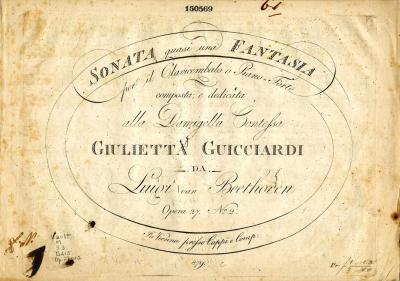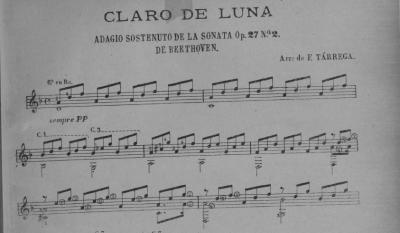You can get the Moonlight Sonata Guitar TAB arranged by Francisco Tárrega here.
Download the Moonlight Sonata Guitar TAB arranged in A minor here.
Moonlight Sonata by Beethoven
 Ludwig van Beethoven’s piano sonata No. 14 in C# minor, also known as the “Moonlight Sonata,” is one of the most treasured piano works in Western classical music. He wrote it for his pupil, Julie “Giuletta” Guicciardi in 1801 and published it the following year. Beethoven was still quite young, being only 30 when he penned the work.
Ludwig van Beethoven’s piano sonata No. 14 in C# minor, also known as the “Moonlight Sonata,” is one of the most treasured piano works in Western classical music. He wrote it for his pupil, Julie “Giuletta” Guicciardi in 1801 and published it the following year. Beethoven was still quite young, being only 30 when he penned the work.
The sonata has three movements and its original title was “Sonata quasi una fantasia” (sonata like a fantasy). A fantasia is a free, almost improvisatory form. So while Beethoven wrote the piece in sonata form, he wanted it to have a free character.
“Moonlight” Sonata
By far the most popular movement is the first, “Adagio sostenuto.” While it was never known as the “moonlight” sonata during Beethoven’s lifetime, this first movement came to be so known soon after his death. In 1852, historian Wilhelm von Lenz wrote about the so-called “Mondscheine Sonate” (Moonshine Sonata). This was the designation that Ludwig Rellstab gave to it probably around 1832, comparing the flow of the first movement to a boat visiting Lake Lucerne by moonlight. Go here to read Andrew Crumey’s full story on why this sonata came to be called “moonlight.”
This movement is in sonata-allegro form, which means it consists of an exposition, a development of the theme, and its recapitulation. The original piano score is in cut, or alla breve, time, which would indicate a slightly faster tempo than it is sometimes played. The right hand plays a triplet ostinato throughout along with the melody, while the left hand plays long-held bass notes. Almost all of this movement is to be played pianissimo.
Above the first measures Beethoven writes, “Si deve Suonare tutto questo pezzo delicatissimamente e Senza Sordino.” In other words, play the entire piece very delicately and without dampers (or mutes). This means to play the entire piece with no dampers between the strings and hammers. Go here for more on this instruction in Beethoven’s Moonlight Sonata.
And then, between the treble and bass staves, Beethoven writes, “Semper pianissimo e senza sordino.”
Moonlight Sonata for guitar: Francisco Tárrega
 Francisco Tárrega was the first to arrange the first movement of Beethoven’s sonata for guitar. While no date is listed on the publication, music editor Ildefonso Aliers first printed it in Madrid.
Francisco Tárrega was the first to arrange the first movement of Beethoven’s sonata for guitar. While no date is listed on the publication, music editor Ildefonso Aliers first printed it in Madrid.
Tárrega’s arrangement is in the key of D minor (one semitone up from the original C#m). And it is in common, rather than cut time. He uses a Drop-D tuning on the sixth string to maximize the low resonance of the bass line.
Learning to Play Moonlight Sonata for Guitar
Voicing
The triplets in the upper voice should be steady and relaxed throughout. Tárrega also includes Beethoven’s instruction “sempre pp,” and so it’s important to keep everything soft and relaxed. In his arrangement, Tárrega places the melody in the middle voice and is mostly played on the bass strings.
Polyrhythm
Speaking of the melody, often that middle-voice melody uses a dotted-eighth and sixteenth rhythm. This can be difficult to count alongside triplets. Essentially you need to count three against four, which is especially challenging. The best way is to use a metronome set to a slow quarter-note tempo. Now alternate counting even triplets to each quarter-note pulse and even sixteenth-note to each quarter note pulse.
You can count: Trip-uh-let, Trip-uh-let, Trip-uh-let, Trip-uh-let. Then change to: 1-e-and-a, 2-e-and-a, 3-e-and-a, 4-e-and-a. Continue alternating between them until the two rhythms feel natural and you can switch between them easily. Then work to put them together in the context of the music.
Two Editions
Francisco Tárrega’s Arrangement in D minor
The first edition is a modern transcription of Tárrega’s arrangement, bringing this classic of the guitar repertoire to you in easy-to-read TAB format. We have preserved all of Tárrega’s fingerings, string numbers, and barres for the most part. While you may find that fingerings are sparse in some places, keep in mind this is a Grade 8 piece and so working to find fingerings that work for you should be part of learning the music. In some cases, however, there are very few alternative fingerings that work and so you’re bound by one, maybe two ways to play the same passage. You’ll need to be creative with your fingering choices and work to bring out the melody and bass as best you can.
You can get the Moonlight Sonata Guitar TAB arranged by Francisco Tárrega here.
Our Arrangement in A minor
We decided to create our own arrangement in the key of A minor, which makes it a bit easier to play. However, this version still features extremely difficult passages throughout especially for the left hand. We encourage you to try both, but in some cases a good and reasonable fingering may mean needing to alter the texture in some way: letting off a bass or melody note early, altering the triplet pattern by removing a note, and so on.
Agustín Barrios also created an arrangement in the key of A minor. Ours shares similar features in some places, but we have tried to stay more faithful to the piano original in places and we have also opted for different fingerings for some passages.
Download the Moonlight Sonata Guitar TAB arranged in A minor here.

Leave A Comment